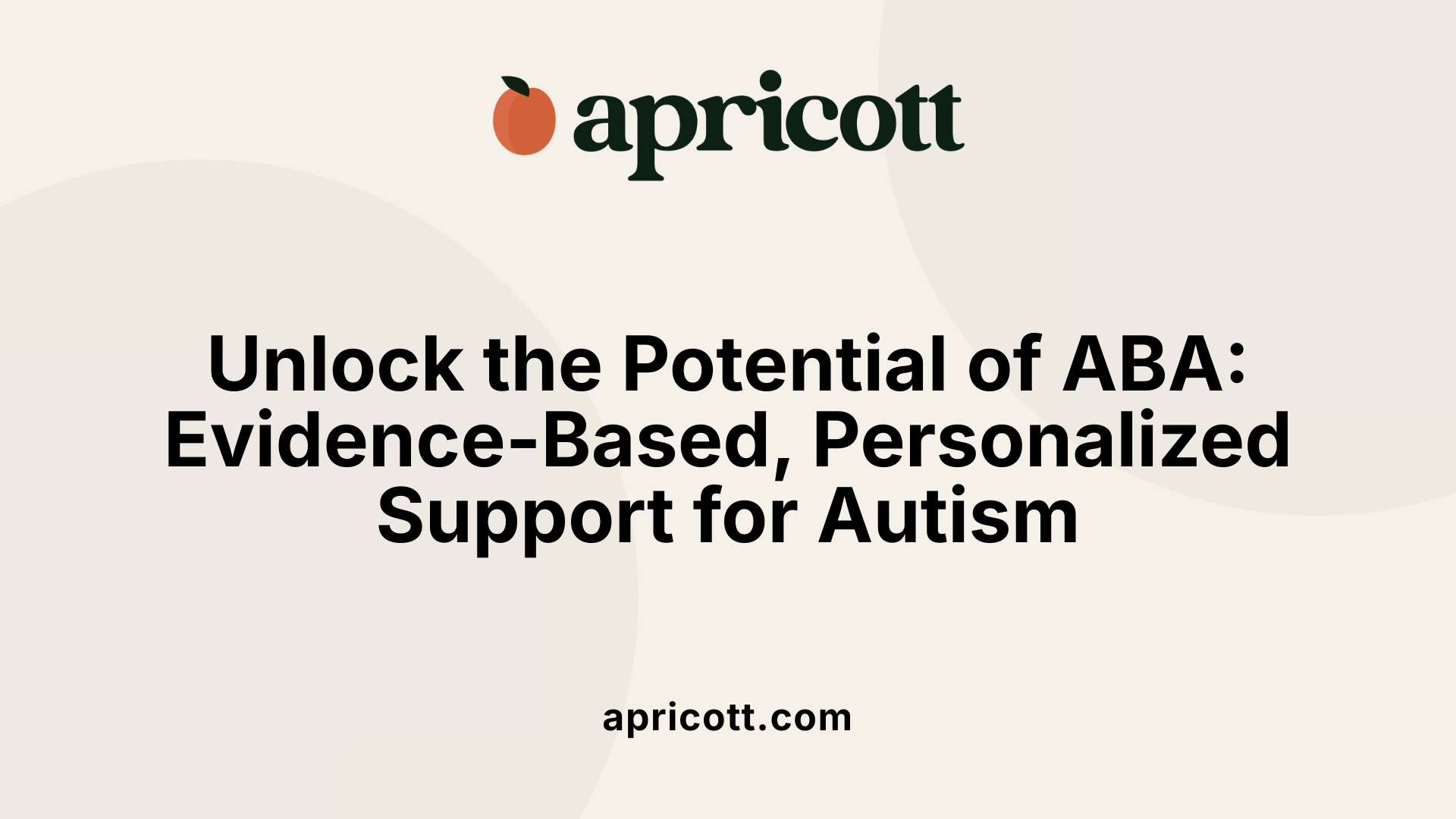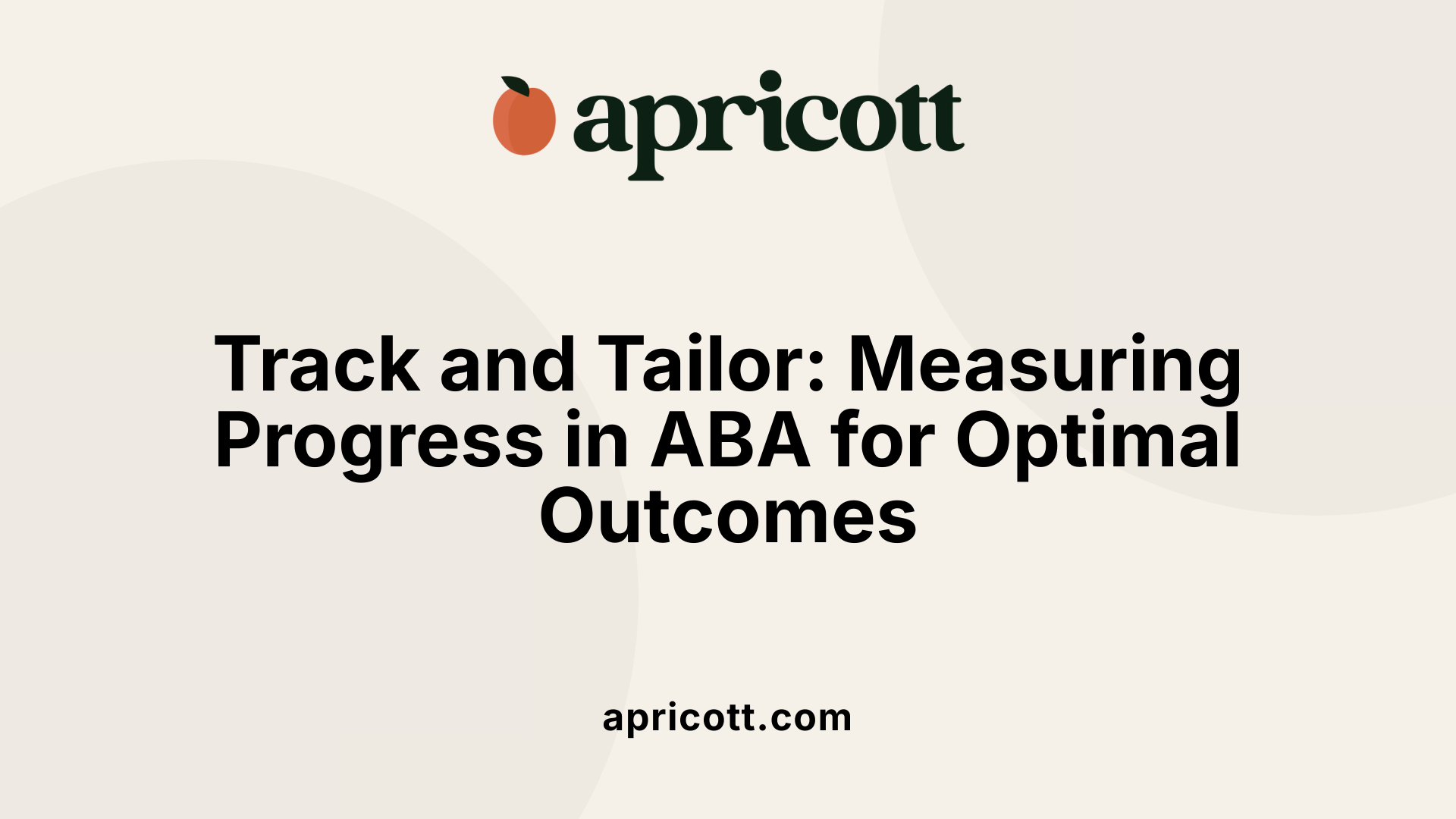Exploring Effective Approaches for High-Functioning Autism
High-functioning autism, a term often used to describe individuals on the autism spectrum who exhibit average to above-average intelligence and relatively strong language skills, presents unique challenges and opportunities. This article delves into the therapies and interventions with solid evidence supporting their benefits, focusing on behavioral, developmental, and psychosocial approaches tailored to foster communication, social, and daily living skills. Understanding these strategies empowers families, caregivers, and professionals to make informed decisions that enhance quality of life and independence for those with high-functioning autism.
Applied Behavior Analysis (ABA): The Cornerstone of Autism Therapy

What is Applied Behavior Analysis (ABA) therapy and how does it help individuals with autism?
Applied Behavior Analysis (ABA) is a therapy rooted in the science of learning and behavior. It seeks to understand how behavior works, its environmental influences, and how new skills are acquired and generalized. ABA therapy supports individuals with autism by promoting positive behaviors and reducing challenging ones through a structured and evidence-based approach.
Core goals and principles
ABA focuses on increasing helpful behaviors such as communication, social skills, attention, memory, and academics. Simultaneously, it aims to decrease behaviors that interfere with learning or safety. The therapy uses the 'A-B-Cs' framework—understanding what happens before a behavior (antecedent), the behavior itself, and its consequences. Positive reinforcement, where rewarding desired behaviors encourages their repetition, is a foundational principle.
Individualized approach
Every ABA program is uniquely tailored by certified behavior analysts (BCBAs) after comprehensive assessments. These programs break down skills into small, concrete steps and use data-driven methods to monitor progress. Interventions can be delivered in various environments like homes, schools, or communities and may incorporate one-on-one or group instruction, always emphasizing enjoyable and socially engaging learning experiences.
Early intensive intervention benefits
Research shows that starting ABA therapy early—especially intensive programs involving 25-40 hours per week over one to three years—significantly enhances intellectual functioning, language skills, daily living capabilities, and social functioning for many children with autism. Approaches like the Early Start Denver Model (ESDM) combine ABA principles with developmental and play-based strategies for children aged 12-48 months, yielding notable improvements in cognitive and adaptive areas.
In summary, ABA remains the most supported and comprehensive treatment for autism, championed by many professional authorities for its individualized, measurable, and impactful approach to helping individuals on the autism spectrum fulfill their potential.
Core Techniques in ABA Therapy: Building Skills Through Positive Reinforcement

What are the core techniques used in ABA therapy to address autistic behaviors?
Applied Behavior Analysis (ABA) therapy employs several effective techniques rooted in behavioral psychology to support individuals with autism.
One foundational method is Discrete Trial Training (DTT), which breaks skills into small, teachable components. Each trial involves a clear instruction, the individual's response, and a consequence or reward. This structured, repetitive approach helps reinforce specific behaviors and skills through consistent practice.
Complementing this is Pivotal Response Training (PRT), a more naturalistic ABA technique focusing on 'pivotal' areas—such as motivation and self-management—that broadly enhance learning across behaviors. PRT encourages communication and social skills by embedding learning opportunities within engaging and meaningful activities.
Positive reinforcement plays a central role in ABA. When an individual demonstrates a desired behavior—like using words or gestures to communicate—a meaningful reward follows. This could be praise, a favorite toy, or other incentives tailored to the person’s preferences, encouraging the repetition of helpful behaviors.
Another important strategy is task analysis and prompting. Complex skills are broken down into smaller steps (task analysis), taught sequentially, and supported with prompts (verbal, gestural, or physical). Over time, prompts are faded out once the individual gains independence.
Lastly, Natural Environment Teaching (NET) integrates lessons into everyday situations rather than isolated drills. This encourages generalization of skills learned during therapy to real-life settings, making communication and social interaction more natural and meaningful.
Through these core techniques, ABA therapy carefully builds communication, social skills, and adaptive behaviors, improving overall functioning and quality of life for individuals with autism.
Who Provides ABA Therapy? Qualifications and Professional Standards

Roles of BCBAs and RBTs
ABA therapy is delivered by a team of trained professionals, primarily Board Certified Behavior Analysts (BCBAs) and Registered Behavior Technicians (RBTs). BCBAs are responsible for designing, overseeing, and adjusting individualized treatment programs. RBTs, often under the supervision of BCBAs, carry out direct one-on-one or group ABA therapy sessions.
Educational and Certification Requirements
To become a BCBA, candidates typically earn a bachelor's degree in psychology, education, or related fields, followed by a master's degree focused on applied behavior analysis. They must complete 1,500 to 2,000 hours of supervised practical experience and pass the Behavior Analyst Certification Board's certification exam. RBTs need a minimum of a high school diploma or equivalent and complete specialized training and competency assessments to ensure quality care.
Supervision and Licensing
BCBAs usually hold state licenses requiring continuing education to maintain their credentials. They supervise RBTs closely to ensure program fidelity and safety. Licensing ensures adherence to ethical standards and quality assurance in ABA service delivery.
Settings of ABA Service Delivery
ABA therapy can be delivered across various environments including the child’s home, schools, clinics, and community locations. Flexibility in settings allows individualized treatment to be implemented where it is most effective, supporting generalization of skills.
Together, these professionals form a structured team offering evidence-based ABA interventions tailored to each individual's needs, ensuring safe and effective therapy that advances communication, social, and adaptive skills.
Measuring Progress and Adapting ABA Interventions

How is the progress of a person undergoing ABA therapy measured and adjusted?
Tracking progress in Applied Behavior Analysis (ABA) therapy relies heavily on systematic data collection and regular assessment to ensure effectiveness and personalized care.
Behavior analysts and therapists gather quantitative data by measuring various aspects of targeted behaviors and skills. These include frequency (how often behaviors occur), duration (how long behaviors last), latency (time between a prompt and response), and accuracy of responses. Such numeric data allow precise monitoring of improvements or challenges.
Alongside these quantitative measures, qualitative observations provide context about the individual’s engagement, motivation, and social interaction quality.
Standardized assessment tools like the Verbal Behavior Milestones Assessment and Placement Program (VB-MAPP) help establish baseline skills and periodically evaluate developmental gains. This assists therapists in identifying areas needing more focus or adjustment.
Data collected are analyzed continuously to track whether therapy goals are being met. Visual aids such as progress charts and graphs often illustrate trends for therapists, parents, and caregivers, helping everyone involved visualize growth and decision points.
Therapy plans are flexible; when progress slows or plateaus, adjustments are made. These can include changing teaching methods, modifying reinforcement strategies, or introducing new goals. This individualized adaptation maximizes the therapy's relevance and effectiveness.
Parent and caregiver involvement is essential throughout this process. Their feedback during sessions and outside observations add valuable insights into the individual’s behavior in natural settings. Collaborative communication helps ensure continuity of learning and generalization of skills beyond therapeutic environments.
Overall, the combination of detailed data collection, assessment tools like the VB-MAPP, ongoing analysis, and partnership with families creates a responsive framework that supports continual progress and individualized care in ABA therapy.
Addressing Criticisms and Ethical Considerations in ABA Therapy

Are there any controversies or criticisms surrounding the use of ABA therapy for autism?
Applied Behavior Analysis (ABA) has long been the most supported and widely accepted behavioral intervention for autism spectrum disorder (ASD). However, it is not without controversy. Historically, some forms of ABA included aversive methods, such as electric shocks, which are now understood to be inhumane and are no longer part of ethical practice. These early approaches raised significant concerns about the well-being of autistic individuals and led to criticism from the autism community and advocates.
Today, criticisms mainly focus on the potential psychological impact of ABA therapy. Some argue that ABA can be too repetitive or heavily focused on eliminating "undesired" behaviors, sometimes encouraging autistic individuals to mask their natural traits to conform to neurotypical standards. Masking can lead to stress, emotional distress, and a feeling that the individual's true self is not accepted. Others worry about the intensity of intervention, where many hours of therapy might limit a child's autonomy or agency, emphasizing compliance over personal choice.
In response, modern ABA has shifted to more ethical and positive reinforcement-based practices. Treatment programs now emphasize individualized plans tailored to each person’s skills, needs, interests, and family context. These programs promote helpful behaviors like communication and social skills while respecting the dignity and preferences of autistic individuals. Ethical ABA prioritizes enjoyable learning and positive social interactions rather than mere compliance.
Respect for neurodiversity—the understanding that neurological differences like autism are a natural part of human diversity—is increasingly recognized as important within ABA and other therapies. This perspective encourages fostering strengths and supporting self-advocacy, rather than attempting to 'normalize' autistic behaviors.
Current consensus among professionals is to ensure ABA therapy is delivered by qualified, supervised practitioners using evidence-based, person-centered methods. Safety measures, ongoing progress monitoring, and active collaboration with families help safeguard well-being. While debates continue, there is broad agreement on balancing effective skill development with respect for individuality and autonomy.
| Aspect | Historical Concerns | Modern Ethical Practices |
|---|---|---|
| Techniques | Included aversive methods in past | Positive reinforcement; individualized |
| Focus | Behavior elimination and compliance | Skill-building, autonomy, dignity |
| Psychological Impact | Risk of masking, stress, trauma | Emphasizes enjoyment and social bonding |
| Respect for Neurodiversity | Lacked consideration | Increasingly integrated and valued |
| Professional Standards | Less regulated, variable quality | Qualified BCBAs, data-driven, collaborative |
This evolution reflects ongoing efforts to address past controversies and improve both the ethical standards and outcomes of ABA therapy for individuals on the autism spectrum.
Early Intervention: Leveraging Developmental and Behavioral Synergies
Why Is Early Diagnosis Important for Autism Intervention?
Early diagnosis of autism spectrum disorder (ASD) is crucial because it enables the timely implementation of evidence-based interventions that lead to improved long-term outcomes. Identifying symptoms early allows families and professionals to begin therapies that develop critical communication, social, and cognitive skills during key developmental periods.
What Is the Early Start Denver Model (ESDM)?
The Early Start Denver Model (ESDM) is a comprehensive behavioral and developmental approach designed specifically for young children aged 12 to 48 months. It combines the principles of Applied Behavior Analysis (ABA) with developmental and play-based strategies. ESDM involves parent participation to leverage natural social interactions and play activities, fostering language, social, and learning skills. The approach has been scientifically shown to improve cognitive abilities, adaptive behaviors, and reduce autism symptoms.
What Are the Benefits of Combining Behavioral and Developmental Approaches?
Integrating behavioral methods like ABA with developmental therapies such as speech and occupational therapy results in a more holistic treatment. Behavioral techniques focus on reinforcing positive behaviors, improving skills like communication and socialization, and breaking down complex skills into manageable steps. Developmental approaches complement this by addressing language development, sensory integration, and daily living skills. Such synergy ensures children receive comprehensive support that adapts to their unique needs and promotes generalized learning across environments.
What Is the Role of Parents in Early Interventions?
Parents play a critical role in early interventions by actively participating in therapy sessions and implementing strategies at home. Programs like ESDM emphasize parent involvement, empowering caregivers to reinforce skills and create supportive learning opportunities throughout daily routines. This collaboration enhances consistency and helps children transfer skills to real-world settings, contributing significantly to treatment success.
Combining these elements ensures early intervention is effective, individualized, and maximizes developmental potential during the most sensitive stages of childhood.
Developmental Therapies: Speech, Occupational, and Physical Interventions
Speech and Language Therapy for Communication
Speech and language therapy plays a crucial role in supporting individuals with autism spectrum disorder (ASD) by improving social communication skills. Therapists work on enhancing verbal and nonverbal communication, including the use of gestures, sign language, and augmentative communication aids for nonverbal children. These interventions aim to boost expressive and receptive language abilities, facilitating better interaction with others.
Occupational Therapy for Sensory and Daily Living Skills
Occupational therapy addresses sensory processing issues commonly experienced by individuals with ASD. Customized to each person's unique needs, it focuses on sensory integration techniques that help manage sensitivities and improve tolerance to environmental stimuli. Additionally, occupational therapy teaches essential life skills that promote social independence and daily functioning, enabling greater participation in everyday activities.
Physical Therapy for Motor Coordination
Physical therapy complements these treatments by targeting gross motor skill development, coordination, and balance. Early inclusion of physical therapy enhances a child's ability to participate in daily activities and supports overall physical wellness. This intervention is particularly effective when integrated early in the therapeutic plan.
Integration with Behavioral Methods
Developmental therapies often work in conjunction with behavioral approaches such as Applied Behavior Analysis (ABA). Combining speech, occupational, and physical therapies with ABA techniques—like discrete trial training and pivotal response training—creates a comprehensive intervention plan that supports communication, social skills, motor functions, and adaptive behaviors. Together, these multidisciplinary approaches enable individualized treatment plans that address the broad range of developmental needs in ASD.
Educational Approaches Tailored for Autism: The TEACCH Model
Structure and visual supports
The TEACCH (Treatment and Education of Autistic and related Communication handicapped Children) approach is designed to create highly structured learning environments tailored specifically for individuals with autism spectrum disorder (ASD). One of its central features is the use of visual supports. These can include schedules, work systems, and clear visual instructions that help learners predict their day and understand expectations. Visual frameworks reduce anxiety and enhance comprehension by making abstract concepts more concrete.
Consistency in classroom environments
Consistency is another cornerstone of the TEACCH model. Classrooms are arranged so that physical spaces clearly define different activities such as work, play, breaks, and social interactions. This environmental consistency helps individuals with ASD navigate the day with less confusion and greater confidence. Predictable routines and consistent use of visual cues foster independence and reduce challenging behaviors by lowering uncertainty.
Customization based on individual strengths
TEACCH programs are not one-size-fits-all; they emphasize tailoring instruction to each individual's unique profile of skills, interests, and challenges. Professionals working within the TEACCH framework assess strengths and needs to customize curriculum and teaching strategies. This personalized approach maximizes learning potential and supports engagement by building on what the learner does best.
Benefits for high-functioning individuals
Particularly for individuals with high-functioning autism, TEACCH's focus on visual learning and structured routines can provide essential support in mastering academic, social, and daily living skills. By fostering organization, reducing distractions, and clarifying expectations, TEACCH helps these learners achieve greater independence and social integration.
| Aspect | Description | Benefit |
|---|---|---|
| Visual supports | Use of schedules, visual instructions, and work systems | Enhances understanding and reduces anxiety |
| Environmental consistency | Clearly defined, stable classroom zones | Facilitates independence and reduces confusion |
| Individual customization | Tailoring of lessons to learner strengths | Promotes engagement and maximizes skill development |
| Support for high-functioning ASD | Emphasizes visual and routine-based learning | Improves social skills, academic success, and life skills |
Social-Relational Approaches: Enhancing Emotional and Social Skills
What are DIR and Floor Time?
Developmental, Individual-differences, Relationship-based (DIR) model, commonly called Floor Time, focuses on child-led interactions to foster emotional and social development. Therapists and caregivers engage with children at their current ability levels, encouraging back-and-forth communication and shared attention. This method builds emotional bonds and nurtures social thinking in a naturalistic way.
How does Relationship Development Intervention (RDI) work?
RDI aims to develop social competence by strengthening dynamic social skills and flexible thinking. Unlike structured teaching, RDI emphasizes guided participation in real-life social situations. It helps individuals develop problem-solving abilities, emotional regulation, and perspective-taking, all critical for authentic social relationships.
What roles do Social Stories and social skills groups play?
Social Stories use clear, simple narratives to explain social situations and expected behaviors. They help individuals with autism anticipate and navigate social interactions. Social skills groups provide supportive environments where practicing communication, cooperation, and relationship-building is encouraged, often facilitated by therapists or educators.
Why involve parents and peers in social-relational approaches?
Parent and peer involvement is crucial for generalizing social skills beyond therapy sessions. Parents participate as co-therapists, reinforcing strategies at home, while peers provide natural opportunities for social interaction and friendship development. This inclusive approach strengthens emotional bonds and supports meaningful social growth.
Together, these social-relational methods foster meaningful emotional connections and social capabilities, complementing other therapeutic strategies for autism.
Psychological Approaches for Adults with High-Functioning Autism
Cognitive Behavioral Therapy (CBT) for Anxiety and Depression
Cognitive Behavioral Therapy (CBT) is an effective psychological approach for adults with high-functioning autism, particularly in managing anxiety and depression. CBT helps individuals identify and change negative thought patterns and behaviors that contribute to emotional distress. Evidence shows that CBT interventions can significantly reduce symptoms of anxiety and depression, improving overall quality of life for autistic adults.
Mindfulness-Based Interventions
Mindfulness-based therapies complement CBT by teaching adults to focus on the present moment and develop skills for managing stress and emotional regulation. These interventions have demonstrated promising results in reducing anxiety and depressive symptoms in high-functioning autistic adults, supporting mental well-being through increased self-awareness and relaxation techniques.
Social Skills Training Programs Like PEERS YA
Social skills training is crucial for enhancing interpersonal communication and social responsiveness in adults with autism. Programs like PEERS YA (Program for the Education and Enrichment of Relational Skills for Young Adults) provide structured, evidence-based approaches that teach social rules, conversation skills, and friendship-building techniques. Studies show participants often experience significant improvement in social functioning, with some benefits maintained over time.
Importance of Adaptation and Environmental Supports
Successful psychological interventions for autistic adults depend on tailoring treatments to individual needs. Adaptations such as using clear and concrete language, providing structured sessions, and supporting skill generalization into daily life are essential. Environmental supports include training healthcare providers on autism-specific needs and creating inclusive, supportive settings that enhance engagement and intervention effectiveness.
Complementary and Alternative Treatments: Considerations and Cautions
Common alternative treatments used by families
Complementary and alternative treatments for autism spectrum disorder (ASD) include a broad range of approaches such as special diets, herbal supplements, animal-assisted therapy, and mindfulness practices. These therapies are often sought by families hoping to complement traditional interventions and address symptoms not fully managed by evidence-based treatments.
Importance of consulting healthcare providers
While some families find these approaches helpful, it is crucial to consult with experienced healthcare professionals before starting any alternative therapy. Medical experts can help assess the safety, potential interactions, and appropriateness of these treatments based on the individual's unique medical history and needs.
Safety and appropriateness considerations
Not all complementary treatments have been rigorously studied for effectiveness or safety in ASD. Some dietary changes or supplements may cause adverse effects or interfere with prescribed medications. Ensuring careful monitoring and professional guidance minimizes risks and helps maintain overall health.
Role as supplementary rather than primary treatments
Complementary therapies should not replace established evidence-based interventions like Applied Behavior Analysis (ABA), speech therapy, or occupational therapy. Instead, they may serve as supplementary options to enhance well-being and provide additional support tailored to individual preferences and circumstances.
By approaching complementary and alternative treatments thoughtfully and in partnership with healthcare providers, families can make informed decisions that prioritize safety while addressing holistic needs.
Medications in Autism: Managing Related Symptoms
Are there medications that treat core ASD symptoms?
Currently, no medications are approved or proven to treat the core symptoms of autism spectrum disorder (ASD), such as difficulties in social communication and repetitive behaviors. Medication is not used as a primary treatment for these core features but may play a supportive role when managing related or co-occurring symptoms.
What medications are used to manage related symptoms in ASD?
Certain medications have been approved by the FDA to address specific behavioral symptoms associated with autism. For example, Risperidone and Aripiprazole are commonly prescribed to reduce irritability, aggression, and self-injurious behaviors in children and adolescents with ASD. These medications can help improve daily functioning and quality of life by alleviating challenging behaviors.
How do medications help with symptoms like anxiety and hyperactivity?
Medications may also be used to manage anxiety, hyperactivity, and other mental health issues that often accompany ASD but are separate from the core symptoms. For instance, some individuals might receive treatments similar to those used in attention-deficit hyperactivity disorder (ADHD) or anxiety disorders, guided by careful assessment.
What precautions are necessary when using medications for ASD?
Because these medications can have side effects and require careful dosing, their use must be supervised by experienced medical professionals specializing in developmental disorders. Continuous monitoring is essential to ensure safety and effectiveness, and medication is usually combined with behavioral and psychosocial therapies to provide comprehensive support.
In summary, while no drugs directly treat ASD core symptoms, medications like Risperidone and Aripiprazole can effectively manage related behavioral and emotional challenges under expert care.
Emerging Advances and Future Directions in Autism Treatment
Genetic testing and neuroimaging
Genetic testing and neuroimaging are transforming our ability to diagnose and understand autism spectrum disorder (ASD). These tools help identify genetic variations linked to ASD and reveal differences in brain structure and connectivity, improving early screening and personalized treatment planning. Their integration into clinical practice aids in precision diagnosis and tailoring interventions to individual profiles.
Personalized medicine and gene editing prospects
Personalized or precision medicine holds great promise for the future of ASD treatment. Advances include gene editing techniques, such as CRISPR, aimed at correcting genetic mutations associated with autism. Stem cell therapies are also being explored to address neurodevelopmental anomalies. Although still experimental, these approaches aim to provide targeted treatments that address the root biological causes of ASD.
Artificial intelligence in diagnosis
Artificial intelligence (AI) and machine learning are increasingly applied to enhance early diagnosis and screening for autism. AI algorithms analyze large datasets including behavioral videos, genetic markers, and clinical records to detect subtle patterns indicating ASD. This technology offers faster, more accurate identification and supports clinicians in making informed decisions, potentially leading to earlier interventions and better outcomes.
Global interdisciplinary research and policy impact
Interdisciplinary collaboration and global partnerships are vital to advancing ASD research and treatment. Combining expertise across genetics, neurology, psychology, and technology accelerates breakthroughs in understanding autism. Furthermore, social policies that support research funding and promote inclusion ensure advancements translate into improved quality of life. Efforts to enhance employment opportunities and social integration for individuals with ASD also reflect the importance of policy in shaping future care.
| Emerging Approach | Role in Autism Treatment | Current Status and Impact |
|---|---|---|
| Genetic Testing and Neuroimaging | Aid early diagnosis and personalized intervention | Increasingly integrated in clinical settings |
| Personalized Medicine & Gene Editing | Target underlying genetic causes | Experimental but promising for future therapies |
| Artificial Intelligence | Enhance screening accuracy and speed | Growing use in research and diagnostic tools |
| Global Research & Policy | Foster innovation, funding, and social integration | Essential for sustainable progress and effective care |
Insurance and Accessibility: Navigating ABA Therapy Coverage
Variability in insurance coverage
Insurance coverage for Applied Behavior Analysis (ABA) therapy varies significantly across different regions and insurance providers. While many private health plans include ABA therapy, the extent of coverage, copays, and limits on therapy hours can differ. It is crucial for families to verify specific benefits and understand policy details before starting therapy.
Medicaid and private plans
Medicaid programs often cover ABA therapy when it is prescribed by a licensed physician and deemed medically necessary. Coverage criteria and authorization processes may differ by state, requiring families to navigate complex systems for approval. Private insurance typically also requires documentation of medical necessity, but may have its own requirements for provider credentials and session limits.
Medical necessity requirements
To qualify for insurance coverage, ABA therapy must be prescribed by a medical professional and supported by an individualized treatment plan. Insurance companies usually require evidence that ABA addresses documented developmental or behavioral challenges associated with autism spectrum disorder (ASD). Ongoing progress reviews and data collection are often needed to maintain approval.
Parental guidance for choosing providers
Parents and caregivers should ask ABA providers detailed questions to ensure quality care and smooth insurance processing. Important inquiries include:
- Credentials and qualifications of behavior analysts and therapists
- Safety protocols and supervision standards
- Procedures for setting and reassessing personalized goals
- Methods for tracking and communicating progress
- Session structures and flexibility
- Accepted insurance plans and billing practices
Being informed helps families select competent programs aligned with insurance coverage, fostering better outcomes and financial planning.
Skill-Based Treatment (SBT): An Emerging Approach to Challenging Behaviors
What is Skill-Based Treatment (SBT)?
Skill-Based Treatment (SBT) is an innovative behavioral intervention designed to address challenging behaviors in children with autism spectrum disorder (ASD). It emphasizes teaching functional skills to replace difficult behaviors, promoting safety, trust, and adaptive functioning within a trauma-informed framework.
What are the Core Components of SBT?
SBT focuses on three main skill areas:
- Functional Communication Responses (FCRs): Teaching individuals effective ways to express their needs or discomfort to reduce frustration.
- Toleration Skills: Developing the ability to tolerate demands, sensory input, or environmental changes that might otherwise trigger challenging behaviors.
- Cooperation Skills: Encouraging compliance and participation in everyday activities through positive reinforcement and systematic teaching.
Continuous monitoring of the individual's emotional state is essential to tailor interventions sensitively and maintain safety.
In What Settings is SBT Implemented?
SBT is highly adaptable and can be delivered across multiple environments such as:
- The child’s home
- School settings
- Telehealth platforms
This flexibility allows families and practitioners to maintain consistent support under varied circumstances, increasing access and convenience.
How Does SBT Emphasize Safety and Trauma-Informed Practices?
Central to SBT is building safety and trust with the individual. The treatment respects the individual's emotional state, avoids coercion, and recognizes past trauma that might affect behavior. These principles ensure that interventions are not only effective but also compassionate and supportive.
Research shows that SBT has achieved an average 98.2% reduction in challenging behaviors in studied cases, demonstrating promising effectiveness. However, further larger-scale studies are needed to confirm long-term benefits and generalizability.
| Aspect | Description | Importance |
|---|---|---|
| Functional Communication | Teaching effective expression to reduce frustration | Reduces challenging behavior by enhancing communication |
| Toleration Skills | Building tolerance for demands and sensory inputs | Supports adaptation to daily routines |
| Cooperation Skills | Encouraging participation with positive reinforcement | Enhances compliance and social functioning |
| Implementation Settings | Home, school, telehealth | Increases accessibility and consistency |
| Trauma-Informed Approach | Ensures safety, trust, and sensitivity to past trauma | Promotes therapeutic alliance and safety |
Supporting Lifelong Success for Individuals with High-Functioning Autism
High-functioning autism requires a nuanced understanding of the individual’s unique strengths and challenges. Evidence-based interventions, particularly Applied Behavior Analysis, play a significant role in fostering communication, social interaction, and adaptive skills. Complementary therapies, psychosocial approaches, and emerging innovations further enrich treatment possibilities. Ultimately, personalized, respectful, and ethical care—supported by trained professionals and informed families—lays the foundation for greater independence, well-being, and fulfilling lives across the lifespan.
References
- Treatment and Intervention for Autism Spectrum Disorder
- Applied Behavior Analysis (ABA)
- Psychosocial therapeutic approaches for high-functioning ...
- Evidence-based Treatment Options for Autism
- New advances in the diagnosis and treatment of autism ...
- Skill-based treatment for challenging behavior in autism ...
- How to Become an ABA Therapist - School of Education
.svg)
.svg)








